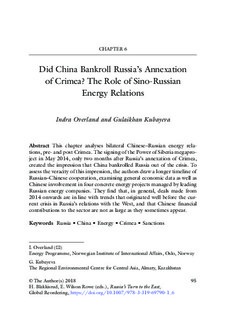| dc.contributor.author | Øverland, Indra | |
| dc.date.accessioned | 2018-10-23T14:57:16Z | |
| dc.date.available | 2018-10-23T14:57:16Z | |
| dc.date.created | 2018-08-24T17:24:20Z | |
| dc.date.issued | 2018 | |
| dc.identifier.citation | H. Blakkisrud, E. Wilson Rowe (eds.), Russia’s Turn to the East, Global Reordering, chapter 6; https://doi.org/10.1007/978-3-319-69790-1_6 | nb_NO |
| dc.identifier.isbn | 978-3-319-69790-1 | |
| dc.identifier.uri | http://hdl.handle.net/11250/2569203 | |
| dc.description.abstract | This chapter is an empirical analysis of energy cooperation between China and Russia, centred on the Ukrainian crisis as a defining event of the partnership. Despite China’s officially neutral political stance on Crimea, the increased frequency of meetings to discuss joint energy projects and the signing of the largest energy deal in world history created the impression that China actively stepped in and supplied the necessary financing to get Russia through sanctions over Crimea and the oil price collapse of 2014–2016. The chapter assesses this hypothesis by examining the long-term trends in lending, investments and trade trends between the two countries, and by taking a closer look at Chinese involvement in four concrete energy projects managed by some of the main Russian energy companies: Power of Siberia, Yamal LNG, Vankor and ESPO. While there is evidence of increased Chinese investments in Russia and a surge of Russian oil imports to China after the annexation, the authors conclude that China was not the major force keeping Russia’s wheels turning during the pre- and post-Crimea years. The involvement of China in the major Russian energy projects was planned and negotiated long before the annexation of Crimea. The authors therefore argue that China did not step in to bankroll Russia after Crimea, instead long-term trends in cooperation simply continued. On the other hand, clearly the long-term growth in cooperation between the two countries reduces Russia’s dependency on the West and provides greater elbowroom for its foreign policy. | nb_NO |
| dc.description.abstract | Did China Bankroll Russia’s Annexation of Crimea? The Role of Sino-Russian Energy Relations | nb_NO |
| dc.language.iso | eng | nb_NO |
| dc.publisher | Palgrave Macmillan | nb_NO |
| dc.relation.ispartof | Russia's Turn to the East - Domestic Policymaking and Regional Cooperation | |
| dc.rights | Navngivelse 4.0 Internasjonal | * |
| dc.rights.uri | http://creativecommons.org/licenses/by/4.0/deed.no | * |
| dc.title | Did China Bankroll Russia’s Annexation of Crimea? The Role of Sino-Russian Energy Relations | nb_NO |
| dc.title.alternative | Did China Bankroll Russia’s Annexation of Crimea? The Role of Sino-Russian Energy Relations | nb_NO |
| dc.type | Chapter | nb_NO |
| dc.description.version | publishedVersion | nb_NO |
| dc.source.pagenumber | 95-118 | nb_NO |
| dc.identifier.cristin | 1604434 | |
| cristin.unitcode | 7471,11,0,0 | |
| cristin.unitname | Russland, Eurasia og Arktis | |
| cristin.ispublished | true | |
| cristin.fulltext | original | |
| cristin.qualitycode | 1 | |

